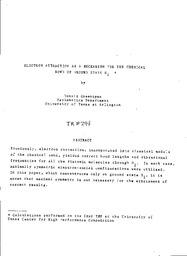
ATTENTION: The works hosted here are being migrated to a new repository that will consolidate resources, improve discoverability, and better show UTA's research impact on the global community. We will update authors as the migration progresses. Please see MavMatrix for more information.
Show simple item record
| dc.contributor.author | Greenspan, Donald | en |
| dc.date.accessioned | 2010-06-09T16:00:22Z | en |
| dc.date.available | 2010-06-09T16:00:22Z | en |
| dc.date.issued | 1993 | en |
| dc.identifier.uri | http://hdl.handle.net/10106/2452 | en |
| dc.description.abstract | **Please note that the full text is embargoed** ABSTRACT: Previously, electron attraction, incorporated into classical models of the chemical bond, yielded correct bond lengths and vibrational frequencies for all the diatomic molecules through 02. In each case, maximally symmetric electron-nuclei configurations were utilized.
In this paper, which concentrates only on ground state H2, it is shown that maximal symmetry is not necessary for the attainment of correct results. | en |
| dc.language.iso | en_US | en |
| dc.publisher | University of Texas at Arlington | en |
| dc.relation.ispartofseries | Technical Report;294 | en |
| dc.subject | Ground state | en |
| dc.subject | H2 | en |
| dc.subject | Maximal symmetry | en |
| dc.subject | Chemical bond | en |
| dc.subject | Electron attraction | en |
| dc.subject | Semiclassical model | en |
| dc.subject.lcsh | Molecular dynamics | en |
| dc.subject.lcsh | Mathematics Research | en |
| dc.title | Electron Attraction as a Mechanism for the Chemical Bond of Ground State H2 | en |
| dc.type | Technical Report | en |
| dc.publisher.department | Department of Mathematics | en |
Files in this item
- Name:
- MathTechReport294.pdf
- Size:
- 329.4Kb
- Format:
- PDF
- Description:
- PDF
This item appears in the following Collection(s)
Show simple item record


